50RENEWABLE ENERGY BACKGROUNDOFFICE OF ENERGYRENEWABLE ENERGY HANDBOOK <strong>2010</strong>A 1.3 BioenergyA 1.3.3 TECHNOLOGIESBioenergy technologies are similar in that they relyon chemically complex and heterogeneous reactions,A 1.3.1 INTRODUCTIONand are versatile in that they can provide solid,liquid or gaseous fuels. <strong>The</strong>se products can be usedOrganic matter, or bioenergy, can be converted intoas transport fuels or to generate electricity and heat.energy (heat and/or electricity) using a variety <strong>of</strong>In some cases, the technology may produce multipletechnologies. Bioenergy technology is a proven,products, such as charcoal, activated carbon, plantmature technology. <strong>The</strong> two main forms <strong>of</strong> bioenergyextracts, fertilisers, soil conditioners, as well asinclude the gasification <strong>of</strong> bioenergy (e.g. organic waste)energy products. <strong>Energy</strong> crops may also be usedunder anaerobic conditions to form biogas (includesto alleviate salinity problems, provide habitat forwaste-to-energy streams such as landfi ll) and thenative fauna, limit erosion, improve water qualitydirect combustion <strong>of</strong> bioenergy to generate energy.and improve nutrient cycling.<strong>The</strong> energy value <strong>of</strong> bioenergy originally comes from <strong>The</strong> basic bioenergy technologies available are:solar energy, through photosynthesis. <strong>The</strong> chemicalanaerobic digestion;energy that is stored in plants and animals, or inthe wastes they produce, is called bioenergy.direct combustion;During conversion processes such as combustion,pyrolysis;bioenergy releases its stored chemical energy.gasifi cation;Bioenergy can be used directly for electricityfermentation; andgeneration, steam for industrial uses, heating, cooking, transesterfi cation.or indirectly by converting it into a liquid or gaseous ·fuel (eg, ethanol from cellulose in woody bioenergy A 1.3.4 GENERATING HEAT AND POWERor starch/sugar crops or biogas from animal waste). Products created in the above technologies in theBioenergy-based generators have the advantage <strong>of</strong> form <strong>of</strong> biogas, producer gas, syngas, ethanol andnot being dependant on weather conditions and can biodiesel can be converted to thermal energy bydeliver output at specifi c times <strong>of</strong> demand, providing combustion. Electrical energy is achieved by conversionmaximum fi nancial return, due to the inherent <strong>of</strong> the thermal energy via a number <strong>of</strong> different methods.energy storage in bioenergy.<strong>The</strong> current technologies capable <strong>of</strong> converting theseproducts into useable forms <strong>of</strong> energy include:A 1.3.2 BIOENERGY RESOURCESreciprocating gas engines;<strong>The</strong>re are many types <strong>of</strong> bioenergy that can be utilised gas turbines;as a resource for renewable energy. <strong>The</strong>se resourcesboiler and steam turbines;can be grouped under the following broad headings:Stirling engine; and<strong>Energy</strong> crops – e.g. fast growing agricultural crops· fuel cells (potentially).and forestry species;·Agricultural crop residues – e.g. straw,A 1.3.5 CURRENT APPLICATIONS·husks and stubble;In 2007, less than one per cent <strong>of</strong> Australia’s totalForestry residues – e.g. sawmill andenergy supply was generated using bioenergy.·plantation residues;In comparison, the USA generates 40 terawattAnimal wastes – e.g. manure and abattoir wastes; hours <strong>of</strong> electricity. This is equivalent to the entireIndustrial wastes – e.g. fruit and vegetable scraps grid-connected electricity demands <strong>of</strong> Western·and processing wastes;Australia, South Australia and Tasmania combined.Bioenergy contributes 14 per cent <strong>of</strong> Finland’sMunicipal solid (green); and· Waste sewage. energy needs, 6 per cent in Denmark and delivers5 per cent in Sweden.Mallee has the potential to be a large-scale salinitycontrol crop and source <strong>of</strong> bioenergy for industrialproducts and electricity generation. <strong>The</strong>re is alsosignifi cant potential to generate energy from plantationharvest residue in Western Australia. <strong>The</strong> applications<strong>of</strong> bioenergy can be categorised for use as transportfuels, heating, cooling or electricity generation.75963- 0
·=A 1.4 Hydro <strong>Energy</strong>A 1.4.1 INTRODUCTIONHydro-electric power refers to electricity producedby the movement <strong>of</strong> water from rivers and lakes.It is the most established and mature form <strong>of</strong>renewable energy, with commercial hydro plantsoperating since the late 1800s.Globally, hydroelectric output increased by 2.8 per centin 2008. China accounted for all <strong>of</strong> the world’snet increase, with output rising by 20.3 per cent.Today, about 860,000 MW <strong>of</strong> hydro power contributesto one sixth <strong>of</strong> the electricity generation capacity <strong>of</strong>the world. It is estimated that only one third <strong>of</strong> theeconomically feasible hydro power potential worldwidehas been developed so far.A 1.4.2 CURRENT APPLICATIONS<strong>The</strong> installed hydro power capacity in Australiais 7.8 GW, which represents over 6.1 per cent <strong>of</strong>Australia’s total energy supply.<strong>The</strong> advantages <strong>of</strong> hydro power include:virtually free generation <strong>of</strong> energy once·the dam is built;water can be stored above the dam ready to cope·with peaks in demand;possibility to supply rated power output very·quickly after start, unlike other power stations; andcontinuous generation <strong>of</strong> electricity.However, Western Australia has few suitable sitesfor signifi cant hydro-electric facilities and nonenear major load centres. <strong>The</strong> establishment <strong>of</strong> newlarge-scale hydro power schemes in Australia isunlikely due to widespread environmental concernsregarding the fl ooding <strong>of</strong> large areas <strong>of</strong> land.OFFICE OF ENERGYRENEWABLE ENERGY HANDBOOK <strong>2010</strong>A 1.5 Wave <strong>Energy</strong>A 1.5.1 INTRODUCTIONWave energy could <strong>of</strong>fer an alternative source <strong>of</strong> baseload power. <strong>The</strong> regular storms in the Southern Oceanalong the southern coastline <strong>of</strong> Australia deliverconstant swells to the shoreline, making wave energyhighly predictable and reliable.Waves, particularly those <strong>of</strong> large amplitude,contain large amounts <strong>of</strong> energy. Wave energycan be considered a stored and concentratedform <strong>of</strong> solar energy, since the winds that producewaves are caused by pressure differences in theatmosphere arising from solar heating.A 1.5.2 POTENTIALIt is estimated that near-shore wave energy couldprovide four times our current national power needs.By utilising just 10 per cent <strong>of</strong> this potential waveenergy, around 35 per cent <strong>of</strong> Australia’s currentpower demand could be supplied through thisrenewable energy source.A 1.5.3 TECHNOLOGIESThree approaches to capturing wave energy are:fl oats or pitching devices;·oscillating water columns (OWC); and·wave surge or focusing devices.·However, the attempts to design and deploycost-effi cient devices have been met with limitedsuccess (the main success being the use <strong>of</strong> waveenergy to power several hundred navigation buoys).A renewed interest in wave energy throughout theworld has been seen, with several companiescurrently developing and deploying new devicesthat represent a signifi cant improvement overolder concepts.51RENEWABLE ENERGY BACKGROUND

















